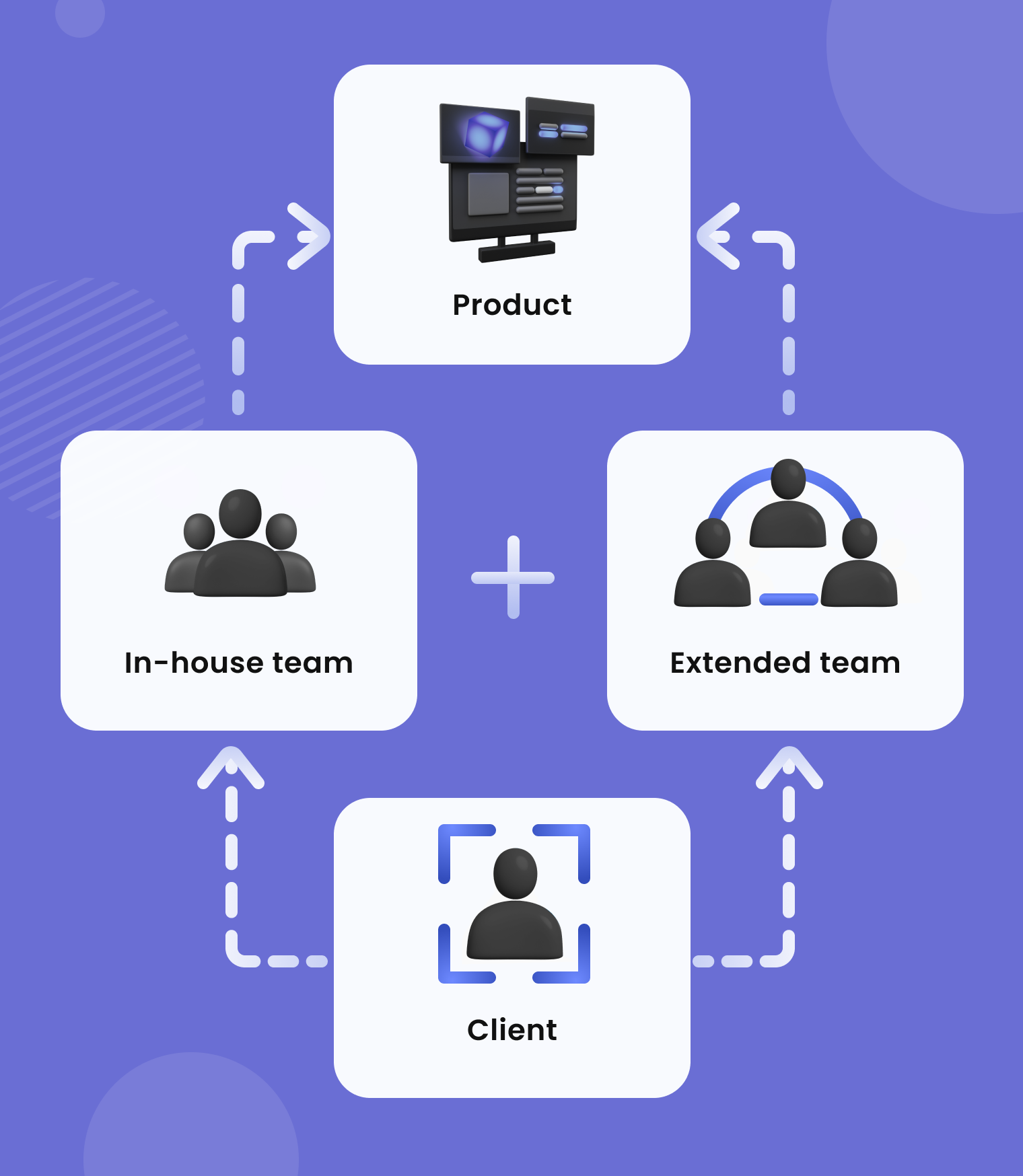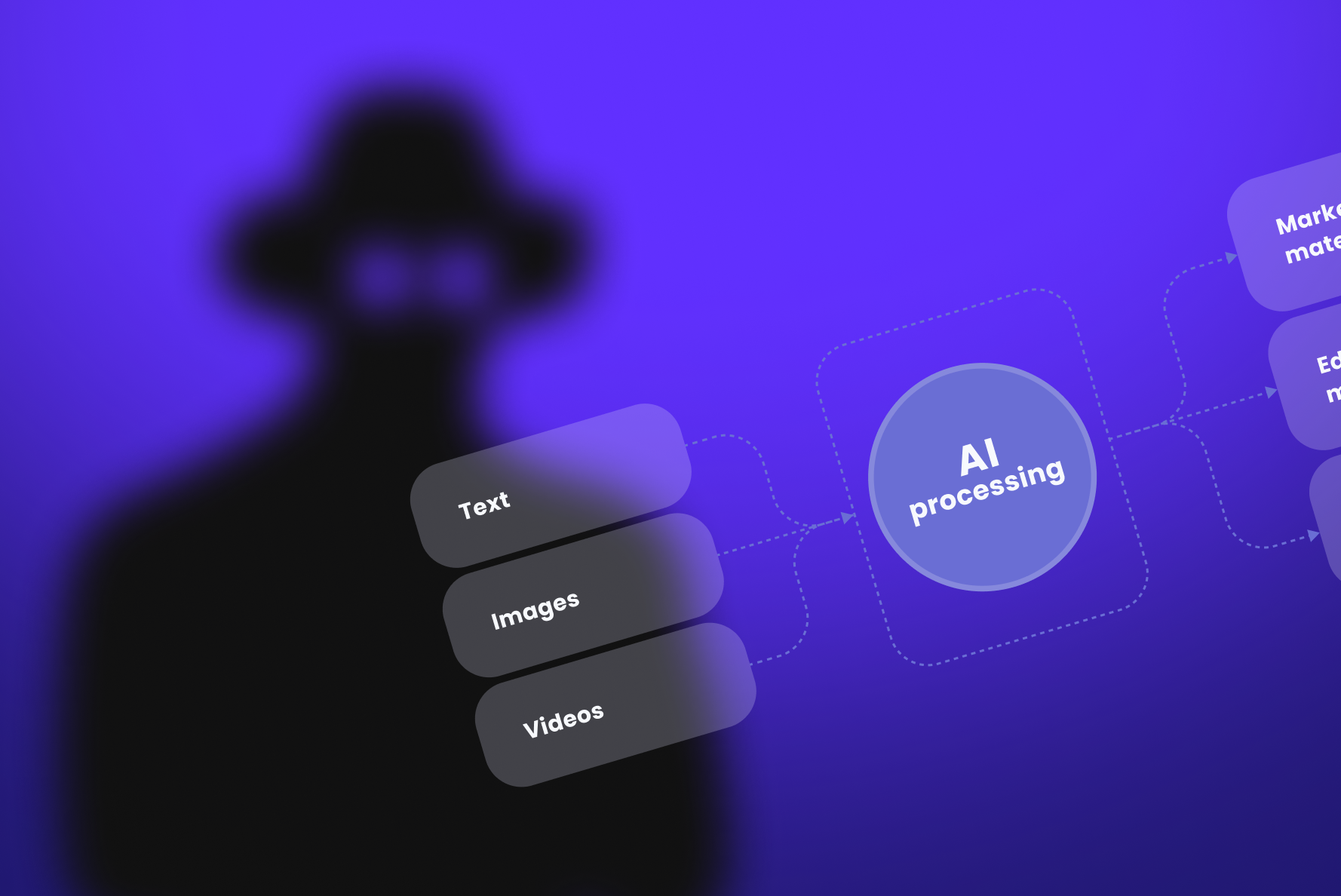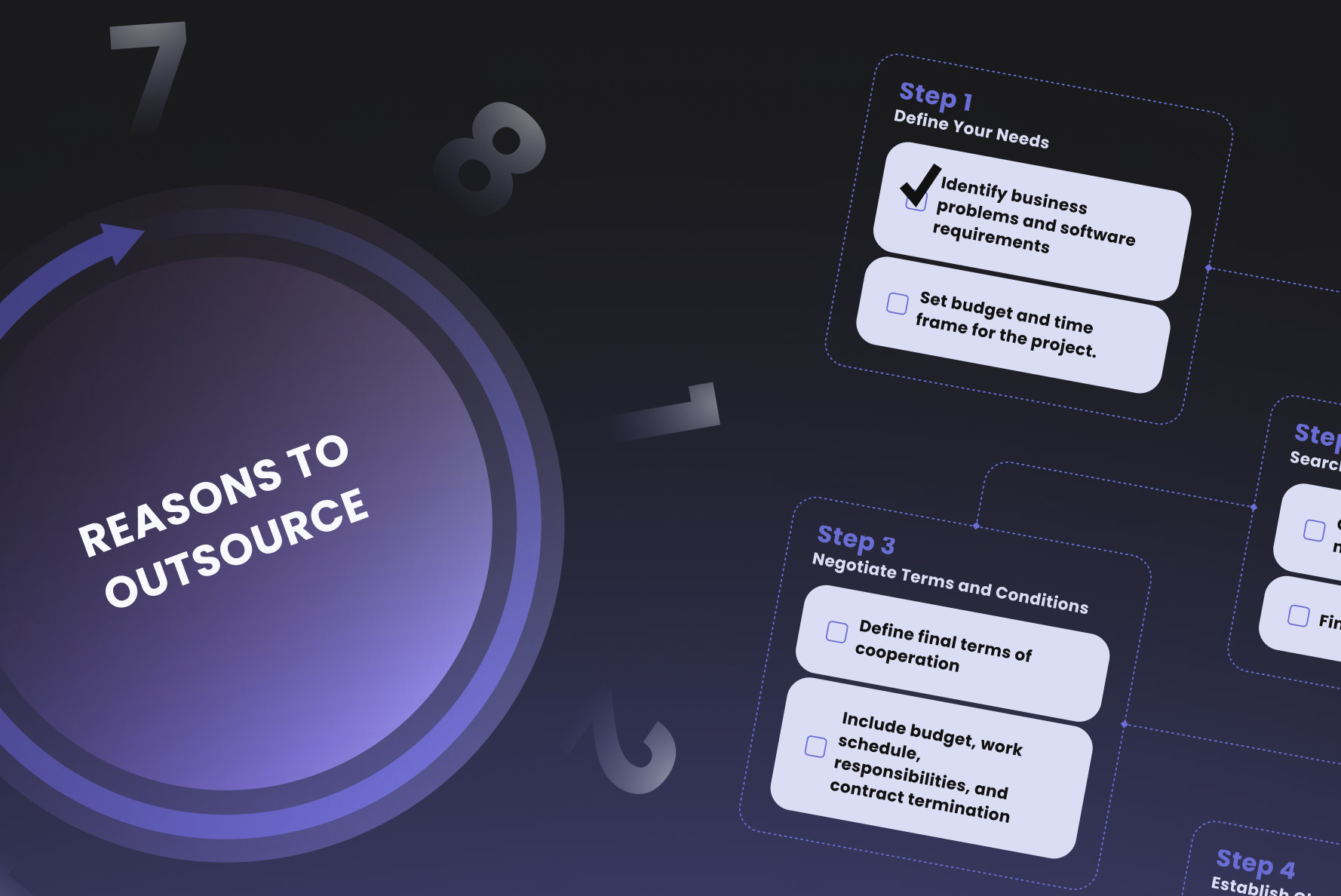Expanding your team is the first thing you would think of when the project scope turns out too heavy for the technical staff you currently have. However, the traditional recruiting and hiring process is not the best choice if you want to send the product to market on time. What can be an alternative?
Software team extension services from a reliable tech vendor will help you hire a tech expert within a few days and keep your project going. Unlike IT staff augmentation whereby you fill in the gaps in an existing team, team extension is about scaling fast and finding more human resources to do the niche expert work.
UVIK, an experienced provider of software team extension and consulting services, will walk you through each step of the way, show the difference between other popular staffing models, and let you in on the secrets of successful team integration. Let’s start with clearing out the most important question.
What is Development Team Extension Model?
The software development team extension means hiring remote professionals from a tech vendor to complete the skillset gap of your in-house team. It can be visualized like this:

By using this model to create the project tech team, you will add to the reliability of your in-house department and complement it by the niche skills of the outstaffed professionals.
But that’s not the only feature of this type of remote hiring. Here’s what you should keep in mind when opting for software team extension services.
- The responsibility for the project lies on those who manage the in-house team. It can be you, your chief technology officer (CTO), or your project manager (PM).
- Extended software development teams complement your in-house team. It means you’re paying for the talent who will help your team and your company turn your idea into a product.
- The company that uses the software team extension model is responsible for the initial development phase. In other words, the company should have the product idea, product feature list, complete discovery stage, and the list of required tech skills before engaging the extended teams. New software engineers can still consult and suggest better ways, technologies, or processes to make the development easier and faster and the product — more reliable.
- Project management lies on the client’s side. The extended software teams receive the tasks and assignments from the client’s PM or other responsible in-house members and report on the progress directly to them.
You may be wondering how it differs from another popular solution, which is hiring a dedicated team to deal with product development from A to Z. We have the answer.
Development Team Extension vs. Dedicated Development Team Comparison
When extending your development team, you invite a few specialists to fill in a very specific talent and skill gap; meanwhile, the dedicated development team model implies outsourcing the whole development process to another tech team that has all resources and skills needed for end-to-end development.
But that’s not the only difference. Have a look at what to expect from each.
|
Development Team Extension |
Dedicated Development Team |
|
|
The development team extension model will work for those clients who need a few specialists with certain skills to prepare their team to start the project.
The dedicated development team model will work best for those businesses that want to fully outsource the development to the tech vendor because they don’t have an internal tech team or don’t want to hire it permanently.
From our experience, the dedicated development team costs more as it includes end-to-end development and project management. The cost difference often becomes the reason the companies would augment their tech department with the necessary engineers rather than outsource the whole development process to the external team. And if you choose this way, here’s what you need to know.
Extending a software development team has its pros and cons, and you should be well aware of them to make the right business decision. We at UVIK are ready to share a few insights from our experience.
Extended Team Model Pros and Cons
A software team extension model is a popular staffing choice for product development, though it doesn’t serve every business equally well. The reason? The peculiarities of this staffing model, the extended team involvement level, and the responsibilities of each party.
Let’s have a quick look at the advantages and disadvantages of each before we dive deeper.
|
Pros |
Cons |
|
|
Let’s discuss them in detail, specifying what businesses will benefit from this model and what project would better opt for other staffing options.
Advantages of the Extended Team Model
The team extension model works best for tech companies that will require specific talents on long-term projects, as well as those who don’t want to spend extra time and money on recruiting new engineers. Extending a software development team has plenty of advantages for the company that seeks to augment its in-house tech department. Here’s a list of the most common ones.
- Easy and fast recruiting. According to a LinkedIn study, it takes around 44 days to close an IT-related position during regular from-scratch recruiting. With the wide talent pool in outstaffing agencies, this process usually takes up to three days because the candidates are already preselected, interviewed by the senior developers, and sorted by skills and knowledge needed to close a specific skill gap.
- Access to niche skills. Professional tech outstaffing companies already have specialists in niche technologies because they study industry trends and are interested in having well-versed engineers. Outstaffing companies source talents from various countries, so you can hire software developers in Poland, Argentina, or Japan if needed.
- Flexible payment options. When you outstaff IT professionals, you can pay them hourly, weekly, monthly, or per-project. You don’t always have this choice in regular outsourcing, which makes team augmentation a great alternative.
- Hassle-free management and scalability. Since the companies offering extensive IT services have access to a large talent pool, finding a perfect candidate won’t be an issue in case your project needs scaling. As a result, you won’t need to put the development on hold and pay your existing extended development team for being on the bench just to keep them around.
- Faster time-to-market. Software team extension should be your go-to strategy if you’re looking for fast project delivery. You will hire the developers with the relevant expertise and spend less time and effort on onboarding. As a result, product development will take less time than if you go through the regular hiring process.
- Higher reliability. Full-fledged product development outsourcing has its risks as the clients have little to no control over the development progress and speed. In the extended development team model, the development management is fully on the client’s side, which gives clients more visibility into the processes to plan further business moves.
Alongside these advantages come a few drawbacks that you also should know before starting an offshore team extension.
Disadvantages of the Extended Team Model
Here are a few things you should keep in mind, specifically if you’re looking for tech people for short-term projects and are considering team extension.
- Software team extension works best for long-term projects. Project success depends on the quality of communication between the in-house and outstaffed members. The longer the teams collaborate and communicate, the better and more trustful their relationships will be, which will positively influence the development process.
- It will require some training and onboarding. When you extend a software development team, you invite new members into your ecosystem of specific workflows, values, and rules. And even though the people will have the needed skills to jump right into the development, they will need proper onboarding on the company’s working environment and practices, getting to know the team, their responsibilities, and so on.
If you have long-term projects and your HR department easily navigates the onboarding process, you should know how to extend a software development team and when to start this process so you benefit from it. Here are a few cases to consider.
When to Use IT Team Extension?
Before starting with any cooperation model, you should clearly understand your project and available resources to choose the best-fit solution. This includes
- Project scope and key characteristics
- Your existing IT landscape
- Your in-house team skills and competency
- IT resources (available and required)
- Skills your team lacks for successful project completion
- Budget
- Desired time to market
After you have identified these key aspects, you’re ready to evaluate whether an augmented team is a solution for you. UVIK has prepared a list of cases when team extension is the most optimal solution. Here it is.
- Your in-house tech team lacks a specific skill needed for project completion
- The talents with needed skills cost an unreasonable price
- You need to augment your team after the development has started
- You’re looking for niche-skilled specialists
- You want to delegate development to outstaffed specialists to keep your in-house team focused on their core tasks
- You don’t want to deal with HR issues of recruitment and hiring, so you’d rather go straight to choosing the right people among the best-fit candidates
- Your timeframe and budget don’t allow you to hire the specialists yourself
- Your project scope turned out too complex for your in-house team, so you need to hire extra developers as soon as possible to keep up the development pace
If you find any of these cases similar to your scenario, you should consider hiring specialists with the needed expertise to your in-house tech department. Here’s how to extend a software development team in the most time and cost-efficient manner.
How to Extend a Software Development Team and Integrate It Into Your Business
When you see that team augmentation is what you need, the first thing to do is to choose the outstaffing vendor who can provide you with the necessary professionals. Check out the vendor’s:
- Experience in outstaffing (reviews on Clutch, testimonials from previous partners, recommendations)
- Variety of skills and services they offer on their website
- Feedback from their employees and community support on social media
Once you’re happy with your results and have chosen the tech vendor to outstaff from, you need to ensure a smooth team augmentation process. Here’s a step-by-step guide on how to do it right.
- Identify who you need for the project. Understanding the roles and skills you need for the project will simplify the search process. Plus, you’ll learn the approximate software development rates for your chosen specialist as well as the tasks they can perform based on their qualifications and experience.
- Select the best-fit candidate(s). The tech vendor will provide you with a list of the best-fit candidates to choose from. We recommend that you arrange in-person interviews with each candidate before hiring them and see if they are a good culture fit as well. Remember that you invite a person on a long-term basis, so it’s important that your work ethic, culture, and goals align.
- Onboard selected team members. After you have selected the best candidate and signed the contract, it’s time to onboard a new member. First of all, introduce them to the team and identify the communication model you’ll be using during the project. Then you may do a quick overview of the company, its history, values, and other key insights that differentiate you from your competition.
- Choose the management and communication tools. There are plenty of management, project, and progress-tracking tools, so you need to introduce your team to the ones you’ll use for communication and reporting. Make sure that the extended team members know how to use it and understand the key features so you can rest assured there won’t be any communication issues. Also, introduce the new members to those they need to report to.
- Define project scope, developers’ tasks, and workflows for the whole team. After you’ve figured out the communication details, it’s time to assign the team the tasks, and let them in on the project scope, and workflow details.
- Start development. After your team is all set up, it’s time to start the product development process.
The outstaffing members may take some time adjusting to your established workflows and schedules, so it would be great if your in-house team provided them with the support and knowledge base they need to make this process shorter and smoother.
UVIK Experience
With over 13 years of experience in team extension and outstaffing services, the UVIK team knows the ins and outs of these processes. We offer IT staff augmentation services that cover the needs of any-sized projects and businesses. Our developers have valid expertise in software engineering, are skilled in the latest technologies, and are certified by technology providers. All of that makes us a reliable tech partner for your business.
You can hire experienced Python, React.JS, React Native, and Django developers, AI/ML and blockchain specialists, DevOps, and many other skilled engineers to improve your team’s productivity and speed up the development process of mobile and desktop software products. The bonus part? You won’t need to worry about employee expenses, such as vacations, insurance, and sick leaves, as we cover that ourselves.
Ready to Boost Your Team’s Productivity? Contact UVIK!
Team extension is a great way to combine the reliability of your in-house team with the niche skills of the outstaffed developers. Tech vendors offering team augmentation services free you from going through a lengthy and costly hiring process, which allows you to invite any needed specialists at any point of the development cycle fast and hassle-free.
At UVIK, we offer you a variety of experienced professionals and flexible payment options, so you can choose your ideal team member on your terms. Contact us and book a call with our project manager, and let’s discuss what talents you need to improve your development workflow!
FAQ
What’s the difference between an extended development team and a dedicated development team model?
How can I ensure friction-free extended team integration?
How much does the software team extension model cost?












